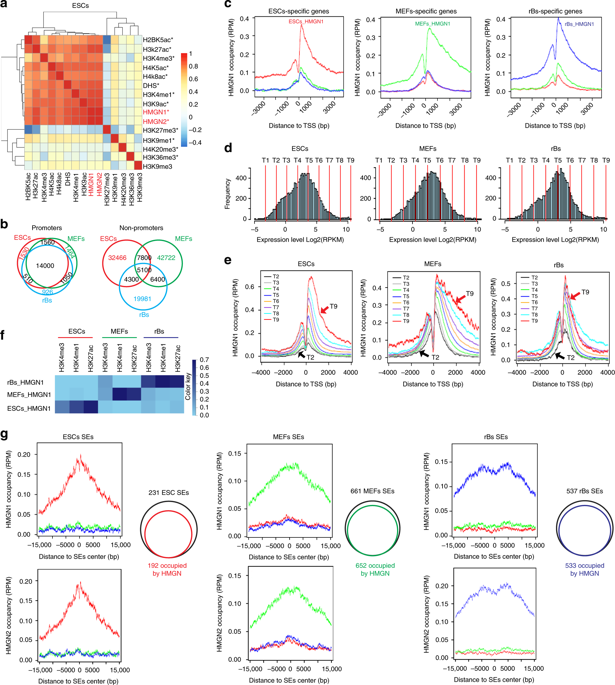当前位置:
X-MOL 学术
›
Nat. Commun.
›
论文详情
Our official English website, www.x-mol.net, welcomes your feedback! (Note: you will need to create a separate account there.)
Binding of HMGN proteins to cell specific enhancers stabilizes cell identity.
Nature Communications ( IF 16.6 ) Pub Date : 2018-12-07 , DOI: 10.1038/s41467-018-07687-9 Bing He , Tao Deng , Iris Zhu , Takashi Furusawa , Shaofei Zhang , Wei Tang , Yuri Postnikov , Stefan Ambs , Caiyi Cherry Li , Ferenc Livak , David Landsman , Michael Bustin
Nature Communications ( IF 16.6 ) Pub Date : 2018-12-07 , DOI: 10.1038/s41467-018-07687-9 Bing He , Tao Deng , Iris Zhu , Takashi Furusawa , Shaofei Zhang , Wei Tang , Yuri Postnikov , Stefan Ambs , Caiyi Cherry Li , Ferenc Livak , David Landsman , Michael Bustin

|
The dynamic nature of the chromatin epigenetic landscape plays a key role in the establishment and maintenance of cell identity, yet the factors that affect the dynamics of the epigenome are not fully known. Here we find that the ubiquitous nucleosome binding proteins HMGN1 and HMGN2 preferentially colocalize with epigenetic marks of active chromatin, and with cell-type specific enhancers. Loss of HMGNs enhances the rate of OSKM induced reprogramming of mouse embryonic fibroblasts (MEFs) into induced pluripotent stem cells (iPSCs), and the ASCL1 induced conversion of fibroblast into neurons. During transcription factor induced reprogramming to pluripotency, loss of HMGNs accelerates the erasure of the MEF-specific epigenetic landscape and the establishment of an iPSCs-specific chromatin landscape, without affecting the pluripotency potential and the differentiation potential of the reprogrammed cells. Thus, HMGN proteins modulate the plasticity of the chromatin epigenetic landscape thereby stabilizing, rather than determining cell identity.
中文翻译:

HMGN蛋白与细胞特异性增强剂的结合可稳定细胞身份。
染色质表观遗传景观的动态性质在细胞身份的建立和维持中起着关键作用,但是影响表观基因组动态的因素尚不完全清楚。在这里,我们发现普遍存在的核小体结合蛋白HMGN1和HMGN2优先与活性染色质的表观遗传标记以及细胞类型特异性增强剂共定位。HMGNs的丢失提高了OSKM诱导的小鼠胚胎成纤维细胞(MEF)重编程为诱导性多能干细胞(iPSCs)的速度,以及ASCL1诱导了成纤维细胞向神经元的转化。在转录因子诱导的重编程为多能性过程中,HMGN的缺失加速了MEF特异性表观遗传景观的删除和iPSCs特异性染色质景观的建立,而不会影响重编程细胞的多潜能和分化潜能。因此,HMGN蛋白调节染色质表观遗传景观的可塑性,从而稳定而不是确定细胞的身份。
更新日期:2018-12-07
中文翻译:

HMGN蛋白与细胞特异性增强剂的结合可稳定细胞身份。
染色质表观遗传景观的动态性质在细胞身份的建立和维持中起着关键作用,但是影响表观基因组动态的因素尚不完全清楚。在这里,我们发现普遍存在的核小体结合蛋白HMGN1和HMGN2优先与活性染色质的表观遗传标记以及细胞类型特异性增强剂共定位。HMGNs的丢失提高了OSKM诱导的小鼠胚胎成纤维细胞(MEF)重编程为诱导性多能干细胞(iPSCs)的速度,以及ASCL1诱导了成纤维细胞向神经元的转化。在转录因子诱导的重编程为多能性过程中,HMGN的缺失加速了MEF特异性表观遗传景观的删除和iPSCs特异性染色质景观的建立,而不会影响重编程细胞的多潜能和分化潜能。因此,HMGN蛋白调节染色质表观遗传景观的可塑性,从而稳定而不是确定细胞的身份。



























 京公网安备 11010802027423号
京公网安备 11010802027423号